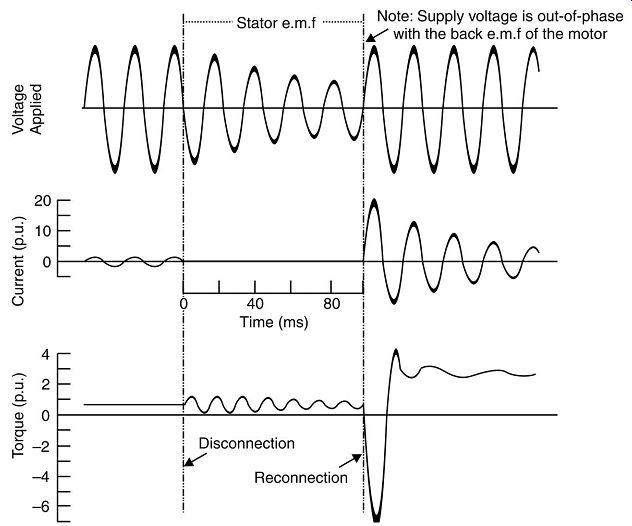Capacitors installed close to induction motors can have the following effects:
• Increasing undesirable torque transients on the rotor
• Self-excitation and capacitive braking.
Torque transients:
A short voltage interruption can cause severe torque peaks in the rotor of an induction motor. In the worst case, this can be more than 20 times the full load torque, and in the direction opposite to the rotation of the rotor. Under loaded conditions, this 'reverse torque' can easily cause severe mechanical damage to the rotor shaft.
The presence of capacitance in the system, especially power factor correction capacitors directly on the motor terminals, will worsen the condition substantially.
AMAZON multi-meters discounts AMAZON oscilloscope discounts 
FIG. 13. Transient torque.
What is "reverse torque":
When a running motor is disconnected from the power supply, a trapped or 'frozen' flux is carried round with the rotor. This flux decays, but induces a rotational emf in the stator windings. When the power supply returns while the rotor is still turning, the induced stator emf may have phase-opposition to the supply voltage at the instant of reconnection.
This will cause severe transients currents and torque, depending on the magnitude of the induced stator emf still present and the degree of phase-opposition. The transient torque so developed may have a negative (retarding) peak.
AMAZON multi-meters discounts AMAZON oscilloscope discountsThe magnitude and direction of the first torque peak are closely dependent on the rotor speed and duration of the interruption, as well as the phase-angle between the induced emf and re-applied voltage. In the worst case the first peak may reach 15 times full load torque (without taking capacitance into consideration). When capacitors are connected to the stator terminals for e.g. power factor correction, more severe transient effects occur. The capacitors tend to maintain the gap flux when the supply is interrupted, and the stator may build up an overvoltage in spite of the drop in rotor speed. When the supply is reconnected with a phase-opposition to the induced stator emf, very severe current and torque transients will occur. The resultant first transient torque peak may exceed 20 times full load torque.
Normally, the control voltage for the main contactor feeding an induction motor is transformed directly from the main supply voltage. The capacitors connected to the stator terminals will tend to keep the voltage level up during a power interruption, which will in turn keep the contactor coil energized, preventing the contactor from opening. Therefore, when the supply voltage comes back after a short period of time, it’s directly applied to the stator, possibly opposing the induced emf already there.
To prevent connected shunt capacitors from worsening the torque transients during voltage interruptions, the capacitor(s) can be disconnected automatically during a severe voltage interruption.
Self-excitation and capacitive braking:
With the magnetizing reactive power provided by a capacitor bank, provided that the rotor has an adequate remnant field, an induction motor may self-excite upon the loss of stator supply. This results in the motor functioning as an induction generator, and stator overvoltages may occur. The capacitance value of power factor correction capacitors may have to be limited to prevent self-excitation.
Self-excitation may be purposely used under controlled conditions for braking. On disconnection of the stator from the supply and its subsequent connection to a capacitor bank, the stator voltages are self-excited to develop a travelling-wave field, and for a generating mode the 'synchronous' speed of the field must be lower than the speed of rotor rotation. The drive power is drawn from the inertia energy and the speed consequently falls rapidly. However, for high-inertia loads that stay mechanically connected to the rotor shaft, forced braking may be undesirable and may even lead to rotor shaft damage.
| Top of Page | PREV: Distribution applications -- shunt capacitors | NEXT: Transformer theory and application | Index |